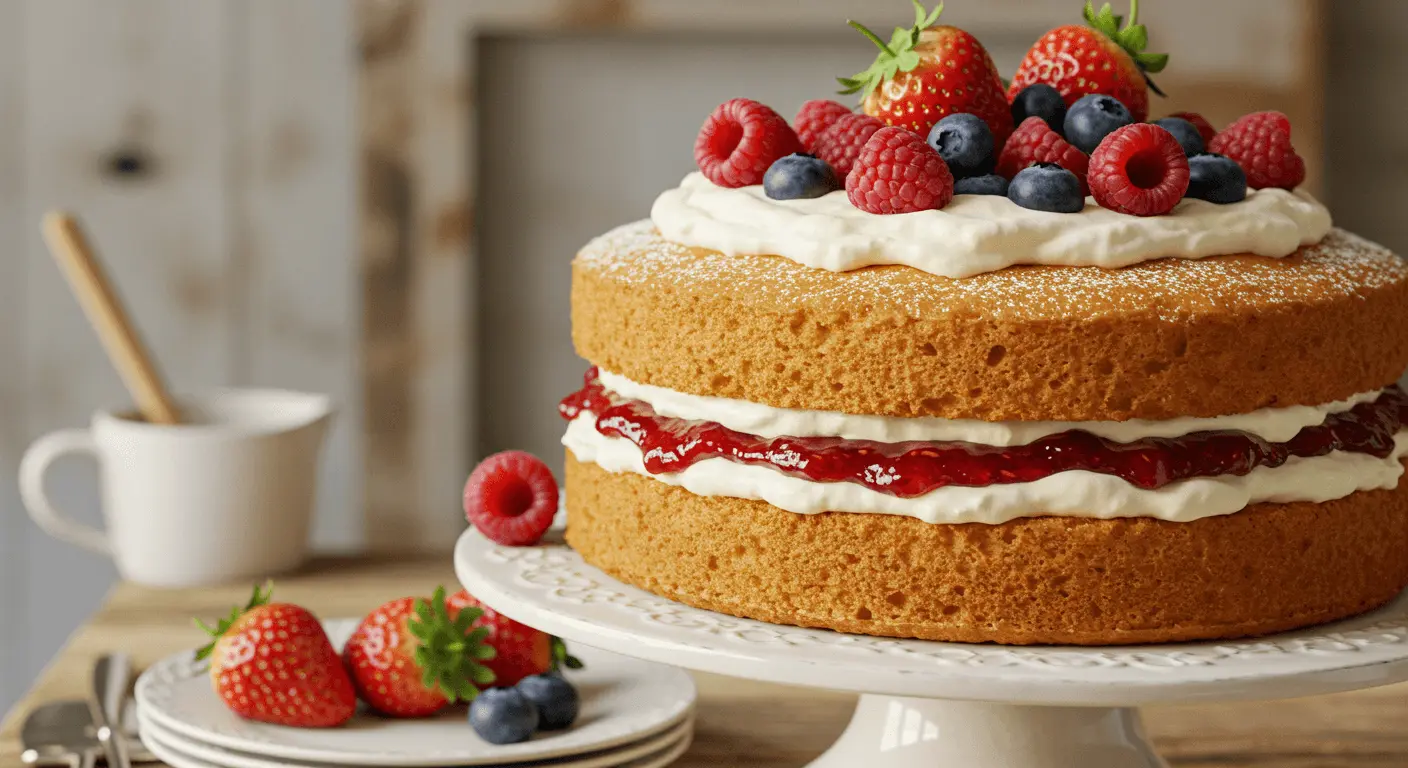Introduction
The Victoria Cake Recipe is a classic British dessert loved worldwide for its simplicity and elegance. This Victoria Cake Recipe guide explores its history and techniques. This guide explores the history and techniques behind creating the perfect Victoria Cake Recipe.
The Victoria Cake recipe Named after Queen Victoria, who was known to enjoy a slice with her afternoon tea, this cake represents the elegance and simplicity of traditional British baking. With its light, airy sponge layers sandwiched together with a generous spread of fruity jam and creamy filling, the Victoria Cake is a delightful treat for any occasion.
Loved for its straightforward ingredients and timeless appeal, the Victoria Cake has become a global favorite, bringing a touch of British charm to tea tables everywhere. Whether you’re a seasoned baker or a beginner, this classic recipe is as rewarding to make as it is to enjoy. In this post, we’ll guide you through every step to create the perfect Victoria Cake, ensuring you achieve a dessert that’s both fluffy and flavorful.
This Victoria Cake Recipe is perfect for anyone who loves a light, fluffy dessert with fruity jam and cream.
Victoria Cake Recipe: A British Classic Dessert
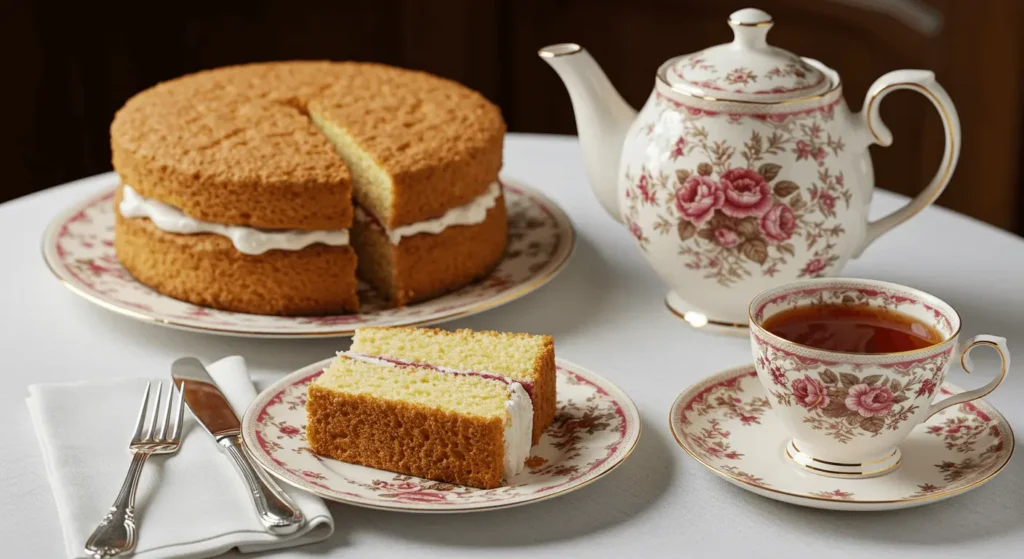
Learn more about the history of this timeless dessert on Wikipedia.
The Origin of Victoria Cake
The Victoria Cake is named after Queen Victoria, who enjoyed it as a part of her afternoon tea ritual during the 19th century. Its origins lie in the Victorian era, where tea culture flourished, and this simple yet elegant dessert became a staple. It’s said that Queen Victoria loved this sponge cake paired with her favorite tea, and soon, the dessert became a symbol of high tea tradition.
Traditional Characteristics
A classic Victoria Cake is defined by its two fluffy sponge cake layers filled with a combination of fruity jam and rich cream. The balance of sweetness from the jam and the lightness of the sponge makes it both satisfying and refreshing. The top is traditionally dusted with icing sugar, creating a minimalistic yet inviting presentation that highlights its natural beauty.
Why It’s Loved Worldwide
The Victoria Cake’s popularity stems from its simplicity, versatility, and universally appealing flavors. Whether it’s served during afternoon tea, birthdays, or celebrations, its timeless charm makes it a favorite across generations. The Victoria Cake Recipe continues to be a timeless dessert that people enjoy baking and sharing. In addition to being a treat for the palate, its ease of preparation has made it a beloved recipe for bakers of all skill levels.
Modern Twists
Although the traditional recipe remains a favorite, modern variations of the Victoria Cake include using flavored creams, adding zesty lemon curd, or incorporating chocolate ganache. These creative adaptations ensure that the cake remains relevant while still paying homage to its roots. For a creative spin on the Victoria Cake Recipe, try adding unique fillings like lemon curd or chocolate ganache.
Why This Victoria Cake Recipe Works Every Time
This Victoria Cake Recipe is foolproof because it follows the classic techniques that ensure success:
- Precise Measurements: Using the right ratio of butter, sugar, eggs, and flour guarantees a light and fluffy texture.
- Step-by-Step Instructions: Each step is crafted to guide even novice bakers through the process.
- Simple Ingredients: The recipe relies on pantry staples, making it easy to recreate at home.
- Customizable Options: Whether you prefer traditional jam and cream or modern twists, this recipe adapts beautifully.
By sticking to these proven methods, you’ll achieve a perfect Victoria Cake every time.
Variations for Your Victoria Cake Recipe
While the traditional Victoria Cake Recipe is timeless, here are some creative variations to explore:
- Flavored Creams: Swap the plain whipped cream for vanilla, chocolate, or citrus-flavored options.
- Fruity Layers: Add slices of fresh strawberries, raspberries, or peaches for a refreshing twist.
- Zesty Additions: Incorporate lemon curd or orange marmalade for a tangy layer of flavor.
- Chocolate Delight: Add a drizzle of chocolate ganache or cocoa powder to the sponge for a richer dessert.
These variations let you personalize the recipe while keeping the essence of this classic dessert intact.
Ingredients for the Perfect Victoria Cake
Essential Ingredients
To achieve the perfect Victoria Cake, you’ll need:
- 200g (1 cup) unsalted butter, softened
- 200g (1 cup) caster sugar
- 4 large eggs
- 200g (1 ½ cups) self-raising flour
- 1 tsp baking powder
- 2 tbsp milk
- 1 tsp vanilla extract
Choosing the Best Jam and Cream
For a truly traditional flavor, use high-quality strawberry or raspberry jam. Fresh heavy cream whipped to soft peaks provides the ideal complement to the jam and sponge layers. Avoid overly sweetened jams as they can overpower the delicate sponge.
Optional Ingredients
While the classic recipe sticks to jam and cream, you can experiment with flavored buttercream or add fresh fruits like strawberries or raspberries to the filling for extra texture and flavor. For a decadent twist, consider adding a layer of lemon curd or a drizzle of honey.
Step-by-Step Instructions to Make a Victoria Cake Recipe
Preparing the Batter
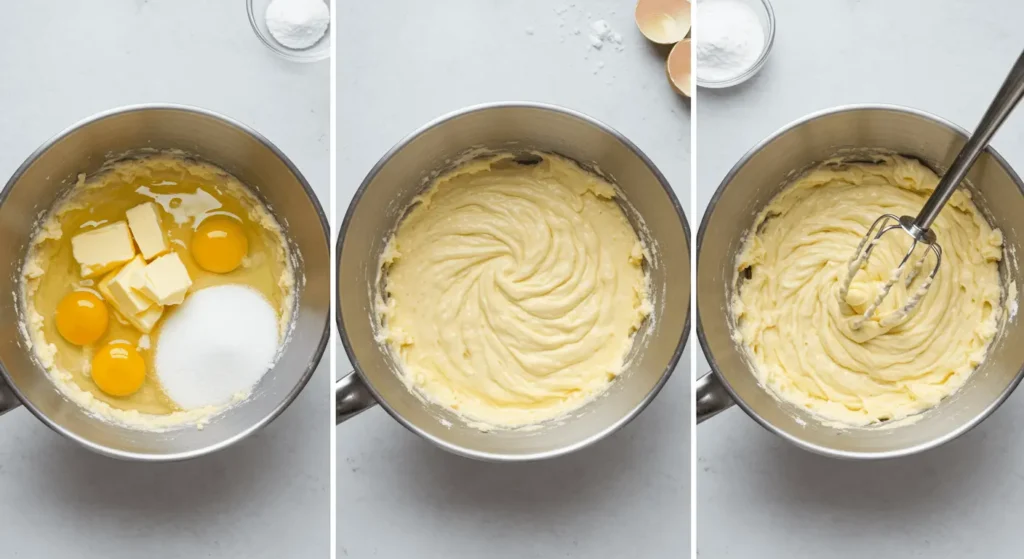
- Preheat your oven to 180°C (350°F). Grease and line two 20cm (8-inch) round cake tins.
- Cream the butter and sugar together in a mixing bowl until light and fluffy. This step is crucial for achieving a light sponge.
- Add the eggs one at a time, beating well after each addition. Stir in the vanilla extract to enhance the flavor.
- Sift the flour and baking powder into the mixture and gently fold to combine. Add the milk to achieve a soft, dropping consistency. Be careful not to overmix, as this can affect the texture of the cake.
Baking the Sponge Layers
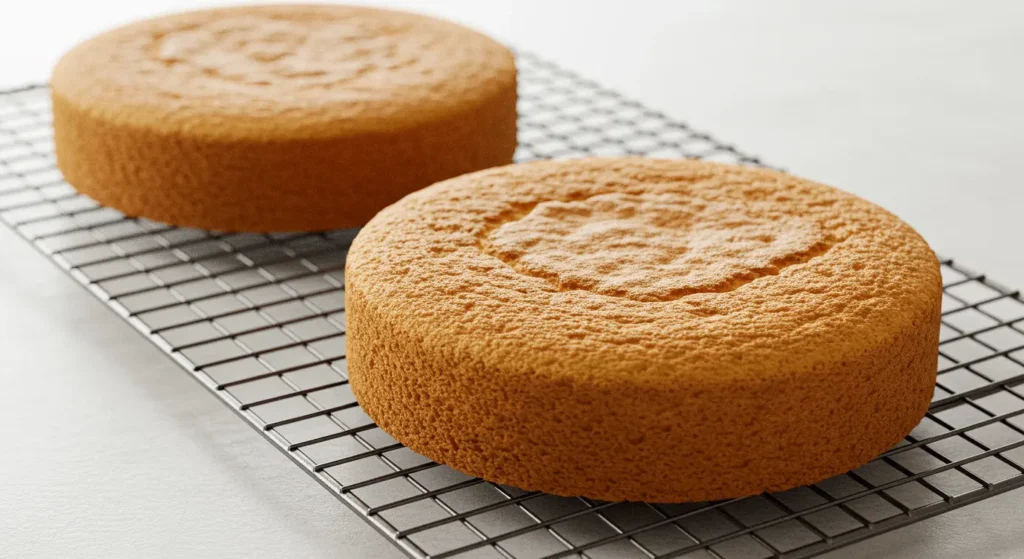
- Divide the batter evenly between the two prepared cake tins.
- Smooth the tops with a spatula and bake for 20–25 minutes, or until a skewer inserted into the center comes out clean. Rotate the tins halfway through for even baking.
- Allow the cakes to cool in the tins for 5 minutes before turning them out onto a wire rack to cool completely. The cooling process ensures the layers remain firm yet moist.
Cooling and Preparing for Assembly
Ensure the sponge layers are completely cool before proceeding. This prevents the cream from melting and ensures clean layering. You can wrap the cooled layers in cling film and refrigerate them for easier handling during assembly.
Assembling and Decorating Your Victoria Cake
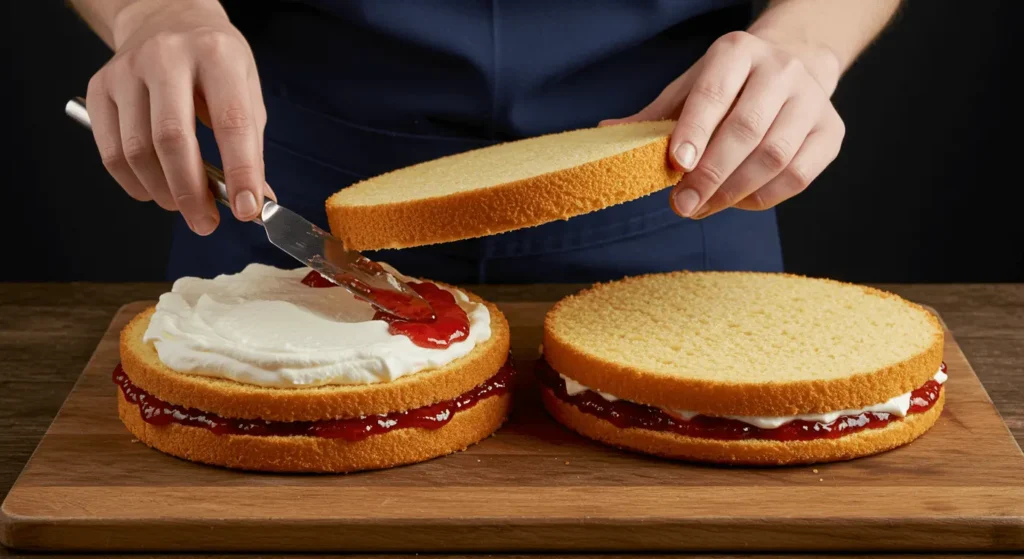
Layering with Jam and Cream
- Place one cake layer on a serving plate.
- Spread an even layer of jam over the top, followed by a generous layer of whipped cream. Use an offset spatula for smooth application.
Creating a Classic Look
Place the second cake layer on top and gently press down. Dust the top with icing sugar for a traditional finish. For an authentic touch, use a doily to create decorative icing sugar patterns.
Optional Decoration Ideas
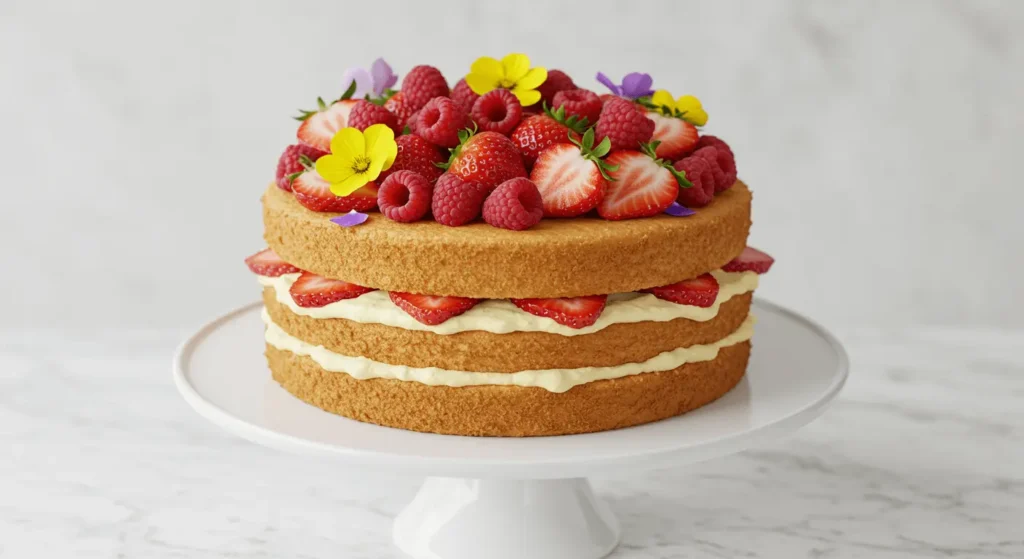
For a more decorative touch, add fresh strawberries, raspberries, or edible flowers. Piped buttercream around the edges can also enhance the presentation. For special occasions, write personalized messages using melted chocolate or colored icing.
Tips for Baking the Perfect Victoria Cake
How to Achieve a Light and Fluffy Sponge
- Cream the butter and sugar thoroughly to incorporate air into the batter.
- Fold the flour gently to avoid knocking out the air.
- Avoid overmixing, which can lead to a dense texture.
- Use room-temperature ingredients for better blending.
Common Mistakes to Avoid
- Overbaking: This can dry out the sponge. Keep an eye on the oven timer.
- Uneven Layers: Ensure equal amounts of batter in each tin by weighing them.
- Warm Layers: Never assemble with warm sponge layers as they can melt the cream.
- Skipping the Sift: Always sift your dry ingredients to avoid lumps and ensure a smooth batter.
Storage Tips
Store the Victoria Cake in an airtight container in the refrigerator for up to 2 days. Allow it to come to room temperature before serving for the best flavor. If you need to prepare it ahead of time, the sponge layers can be frozen and thawed before assembly.
Conclusion
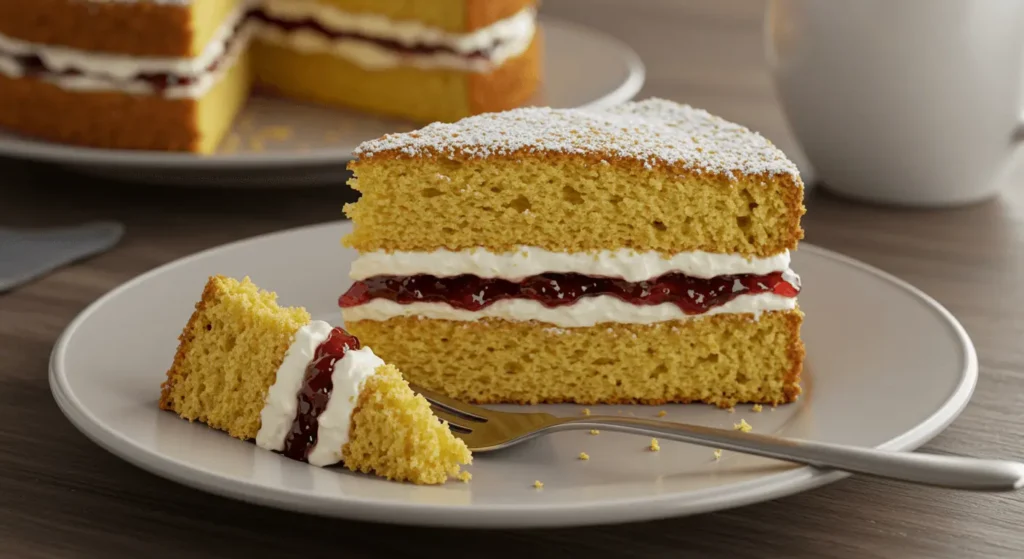
The Victoria Cake is a timeless dessert that’s as delightful to make as it is to eat. Its light, fluffy sponge layers paired with fruity jam and creamy filling make it a perfect treat for any occasion. Whether you’re enjoying it with a cup of tea or sharing it with friends and family, this classic recipe is sure to impress.
Ready to give it a try? Gather your ingredients, follow the step-by-step guide, and create your own slice of British tradition. Don’t forget to share your baking journey in the comments below!

